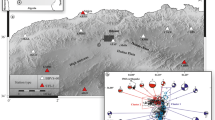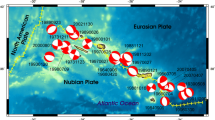Abstract
A long sequence of earthquakes causing few casualties and considerable damage in a wide zone struck Central Italy starting on September 26, 1997. Theearthquakes are characterized by normal faulting mechanism, with a NE-SW(anti-Apenninic direction) tension axis. In this paper we analyze the accelerometric recordings collected by the accelerograph stations belonging to the National Accelerograph Network. About 10 stations were triggered by the mainshocks of the sequence. In particular, a small size foreshock and the two mainshocks that occurred on September,26 (00:33(GMT) MW = 5.7 and 09:40 MW = 6.0) have been recorded by two digital 3-C accelerometers located at near source distances (within 30 km from the faults). These records are relevant to investigate the detail of therupture kinematics, due to the close epicentral distance and azimuthallocation relative to the fault orientation and geometry. Using a trial and error approach we modeled the source mechanism through the fit of the arrival times, the apparent source time duration, the main polarization features and the entire waveforms of the recorded signals, in order to get some insight on the rupture evolution, the location of the fracture origin point and the fault geometry. Based on this fault kinematic model, inferences on fault slip distribution are obtained by modeling the S acceleration waveform, comparing the ray theory synthetics with 1–5 Hz band filtered ground velocity records.The final model shows that the seismic ruptures occurred along two adjacent,sub-parallel, low angle dipping normal faults. Ruptures bothnucleated from the fault bottom and propagated up-dip, showing differentrupture velocity and length. The presence of a transfer zone (barrier)can be suggested by the mainshocks rupture evolution. This transfer zonehas probably controlled the amplitude increase of local stressreleased by the first rupture at its NW edge which triggered about 9 hourslater the second rupture. The inferred model was used to compute the predictedground acceleration in the near source range, using a hybridstatistical-deterministic approach.A similar trial and error method has been also applied to the October 14, 199715:23 earthquake (MW = 5.6). The inferred kinematic model indicates a rupture nucleating from the faultbottom and propagating up-dip, toward the SE direction. Thus the three mainshocks ruptured distinct fault segments, adjacent and slightly offsetfrom one to another.
Similar content being viewed by others
References
Amato, A., Azzara, R., Chiarabba, C., Cimini, G.B., Cocco, M., Di Bona, M., Margheriti, L., Mazza, S., Mele, F., Selvaggi, G., Basili, A., Boschi, E., Courboulex, F., Deschamps, A., Gaffet, S., Bittarelli, G., Chiaraluce, L., Piccinini, D. and Ripepe, M., 1998, The 1997 Umbria-Marche, Italy, earthquake sequence: a first look at the main shocks and aftershocks, Geophys. Res. Lett. 25, 2861–2864.
Aki, K. and Richards, P.G., 1980, Quantitative Seismology, W.H. Freeman, New York, 932 pp.
Bally, A.W., Burbi, L., Cooper, J. and Ghelardoni, R., 1988, Balanced sections and seismic refflection profiles across the central Apennines, Mem. Soc. Geol. It. 35, 257–310.
Bernard, P., Herrero, A., Trifu, C.I. and Zollo, A., 1993, The details of the rupture kinematics and mechanisms of the Irpinia 1980 earthquake: New results and remaining questions, Annali di Geofisica 1, 71–81.
Bernard, P. and Madariaga, R., 1984, A new asymptotic method for the modeling of near field accelerograms, Bull. Seism. Soc. Am. 74, 539–559.
Bernard, P. and Zollo, A., 1988. Inversion of S polarization from near source accelerograms: Application to the records of 1980 Irpinia earthquake (Italy), In: J. Bonnin et al. (eds), Seismic Hazard in Mediterranean Regions, Kluwer Academic, Boston, pp. 59–69.
Bernard, P. and Zollo, A., 1989, The Irpinia (Italy) 1980 earthquake: detailed analysis of a complex normal fault, J. Geophys. Res. 94, 1631–1648.
Camassi, R., Castelli, V., Molin, D., Monachesi, G. and Stucchi, M., 1998, Principali terremoti storici dell'area umbromarchigiana maggiormente interessata dagli eventi sismici di settembre-ottobre 1997, Ingegneria Sismica 15, 1.
Deschamps, A., Iannaccone, G. and Scarpa, R., 1984. The Umbrian earthquake (Italy) of 19 september 1979, Annales Geophysicae 2(1), 19–36.
Ekström, G., Morelli, A., Boschi, E. and Dziewonski, A.M., 1998, Moment tensor analysis of the central Italy earthquake sequence of September- October 1997, Geophys. Res. Lett. 25, 1971–1974.
Farra, V., Bernard, P. and Madariaga, R., 1986. Fast near source evaluation of strong ground motion for complex source models, Earth. Source Mech., Geoph. monigraph, A.G.U. 37, 121–130.
Hartzell, S., 1978, Earthquake aftershock as Green's functions, Geophys. Res. Lett. 5, 1–4.
Haessler, H., Gaulon, R., Rivera, L., Console, R., Frogneux, M., Gasparini, C., Martel, L., Siciliano, M. and Cisternas, A., 1988. The Perugia (Italy) earthquake of 29 april 1984: a microearthquake survey, Bull. Seism. Soc. Am. 78(6), 1948–1964.
Herrero, A. and Bernard, P., 1994. A kinematic self-similar rupture process for earthquake. Bull. Seism. Soc. Am. 84, 1216–1229.
Hunstad, I., Anzidei, M., Cocco, M., Baldi, P., Galvani, A. and Pesci, A., 1999, Modelling the coseismic Displacements during the 1997 Umbria-Marche earthquake, Geophysical Journ. Int. (in press).
Meghraoui, M., Bosi, V. and Camelbeeck, T., 1999. Fault fragment control in the 1997 Umbria-Marche, Central Italy, earthquake sequence. Geophys. Res. Lett. 26, 1069- 1072.
Ponziani, F., 1994, Digitalizzazione e reinterpretazione di dati di sismica crostale: ipotesi su un modello geodinamico per l'Italia Centrale - Tirreno Settentrionale, Phd Thesys, University of Perugia.
Spudich, P. and Frazer, L.N., 1984, Use of ray theory to calculate high frequency radiation from earhquake sources having spatially variable rupture velocity and stress drop, Bull. Seism. Soc. Am. 74, 2061–2082.
Stramondo, S., Tesauro, M., Briole, P., Sansosti, E., Salvi, S., Lanari, R., Anzidei, M., Baldi, P., Fornaro, G., Avallone, A., Buongiorno, M.F., Franceschetti, G. and Boschi, E., 1999. The September, 26 1997 Colfiorito, Italy, earthquakes: modeled coseismic surface displacement from SAR interferometry and GPS, Geophys. Res. Lett. 26, 883–886.
Tento, A., Franceschina, G.L. and De Franco, R., 1998. Experimental site effect evaluation in Nocera Umbra area (Italy). 2nd Int. Symp. on 'The effects of surface geology on seismic motion', december 1- 3, 1998, Yokohama, Japan.
Zollo, A., Capuano, P. and Singh, S.K., 1995, Use of small earthquake record to determine source function of a larger earthquake: an alternative method and an application, Bull. Seism. Soc. Am. 85, 1249–1256.
Zollo, A. and Bernard, P., 1991, How does an asperity break ? New elements from the waveform inversion of accelerograms for the 23:19, October 15, 1979 Imperial Valley aftershock, 1991, J. Geophys. Res. 96, 21549–21573.
Zollo, A., Bobbio, A., Emolo, A., Herrero, A. and De Natale, G., 1997. Modelling of ground acceleration in the near source range: the case of 1976, Friuli earthquake (M=6.5), northern Italy, J. Seismol. 1, 305–319.
Author information
Authors and Affiliations
Rights and permissions
About this article
Cite this article
Capuano, P., Zollo, A., Emolo, A. et al. Rupture mechanism and source parameters of Umbria-Marche mainshocks from strong motion data. Journal of Seismology 4, 463–478 (2000). https://doi.org/10.1023/A:1026523703464
Issue Date:
DOI: https://doi.org/10.1023/A:1026523703464




